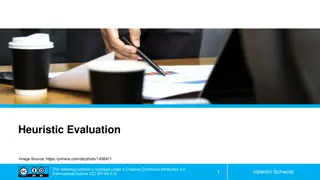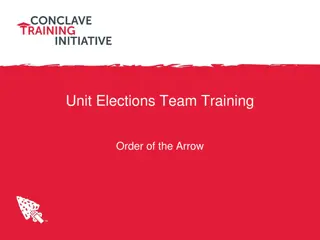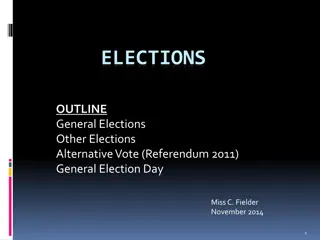Enhancing Usability and Accessibility in Next Generation Elections: NIST Roadmap Workshop Insights
This document reflects the proceedings of a NIST workshop focused on developing usability and accessibility guidelines for modern voting systems. The workshop aimed to address challenges, identify opportunities, and discuss the applicability of existing standards. Despite progress made since the VVSG 2005, barriers persist, hindering the implementation of best practices in voting technology. The roadmap aims to bridge these gaps and leverage new technologies for a more inclusive voting experience.
Download Presentation

Please find below an Image/Link to download the presentation.
The content on the website is provided AS IS for your information and personal use only. It may not be sold, licensed, or shared on other websites without obtaining consent from the author.If you encounter any issues during the download, it is possible that the publisher has removed the file from their server.
You are allowed to download the files provided on this website for personal or commercial use, subject to the condition that they are used lawfully. All files are the property of their respective owners.
The content on the website is provided AS IS for your information and personal use only. It may not be sold, licensed, or shared on other websites without obtaining consent from the author.
E N D
Presentation Transcript
Usability & accessibility of next generation elections NIST Roadmap Notes from the January 9, 2015 workshop Whitney Quesenbery Center for Civic Design Kathryn Summers and graduate students University of Baltimore Sharon Laskowski and Shane Dawkins NIST 1 | Notes from NIST Usability and Accessibility Roadmap Workshop
A preliminary report on the workshop, January 9, 2015 This was the second of two workshops in a process to create a roadmap for developing usability and accessibility guidance, best practices, and standards for next generation voting systems that will help election officials, manufacturers, and other stakeholders to ensure that all voters can vote independently and privately. The roadmap, when completed, will outline steps needed to produce this guidance for election officials, manufacturers, and other stakeholders. It will identify issues, gaps, new technology, and processes, how to develop guidance, as well as relevant research and best practices that can be used to improve voting systems given next generation technology. In this second workshop, we: Worked on possible objectives to include in the roadmap Identified benefits for voters, design challenges, opportunities for the election process, and risks Heard a presentation about the FDA human factors process for approving products and discussed its applicability to voting systems. 2 | Notes from NIST Usability and Accessibility Roadmap Workshop
About the Project 3 | Notes from NIST Usability and Accessibility Roadmap Workshop
Background NIST has worked on voting system standards since the Help America Vote Act of 2002, both establishing requirements for certification test labs and creating the Voluntary Voting System Guidelines (VVSG). The VVSG 2005 included the first comprehensive usability and accessibility standards for voting systems. Elections are changing. There are new technologies, new research, new laws, and new elections procedures since the 2005 Voluntary Voting System Guidelines 1.0 were published. Keeping up with these changes requires a new approach to usability and accessibility guidance for election systems. Recent years have brought changes to the state of the art and technology for voting systems, as well as public expectations about how voters will participate in elections. 4 | Notes from NIST Usability and Accessibility Roadmap Workshop
Background (2) Despite 12 years of work within elections on standards for usability and accessibility, the reality is that there are still many barriers. Even newer systems show poor accessibility and usability, suggesting lack of knowledge of best practices and existing standards and guidelines. This is true of both voting systems and related technology. As more jurisdictions have switched to paper ballots, there is even more isolation of the "accessible" voting system. The accessible systems may go unused through the entire day, further reducing the likelihood that they will be set up and ready to use. Systems for UOCAVA voters under the MOVE Act allow for online ballot marking. Disability rights groups advocate for making these systems available to voters with disabilities (or all voters). Security experts point out many pitfalls. 5 | Notes from NIST Usability and Accessibility Roadmap Workshop
What is a roadmap? A NIST roadmap is an outline for future work. A roadmap: Identifies gaps in knowledge to be filled Identifies issues to be resolved Looks at technology, processes, standards & guidelines Recommend approaches to the work It does not: Prescribe solutions Recommend specific guidelines Rather, it shows how to structure work to accomplish the goals This roadmap will cover future guidance to ensure the usability and accessibility of election systems. 6 | Notes from NIST Usability and Accessibility Roadmap Workshop
Possible goals for the roadmap Increase the level of knowledge for how to design, develop, deploy, and use of usable and accessible elections systems. Promote consistent levels of usability and accessibility across technology in all parts of the elections process. Make systems more usable for everyone in the elections process, including voters, poll workers, elections staff, and third- parties like election interest and advocacy groups or technology developers. Shift from single focus on standards and certification to identifying the appropriate guidance and how to implement the guidance, including: Guidelines for best practices Procedural support Training 7 | Notes from NIST Usability and Accessibility Roadmap Workshop
Where we are in the process October: Workshop 1 - blue sky, get lots of ideas on the table, explore priorities and gaps Workshop 2 Work in detail on elements to be included in the roadmap Feb 9-10: Future of Voting Systems - Present draft of roadmap Feb-March: Public discussion and revisions April-May: Create final version 8 | Notes from NIST Usability and Accessibility Roadmap Workshop
Results of the 2ndWorkshop 9 | Notes from NIST Usability and Accessibility Roadmap Workshop
Workshop participants Paul Aumayr, Maryland Department of Elections Juan Gilbert, University of Florida Dan Gillette, Gillette Design Diane Golden, ATAP Keith Instone, OVF E2E VIV Project Ed Israelski, AbbVie Jonathan Lazar, Towson University Shari Little, ES&S Ryan Macias, California Office of Voting Systems Technology Assessment Greg McGrew, Assistive Technology Partners Jessica Myers, EAC Brian Newby, Election Commissioner, Johnson County, Kansas Jim Tobias, Inclusive Design/Raising the Floor Emily Rhodes, University of Baltimore Caitlin Rinn, University of Baltimore Joel Stevenson, University of Baltimore 10 | Notes from NIST Usability and Accessibility Roadmap Workshop
Structure of the day Introductions and goals for the workshop Recap of work to date Breakout topics: session 1 Lunch talk on human factors in the FDA project Breakout topics: sessions 2 and 3 Readouts and discussion 11 | Notes from NIST Usability and Accessibility Roadmap Workshop
What issues must the roadmap address We started the day by asking everyone to name one top priority for improving the usability and accessibility of future elections. They said: Better understanding of voters and their needs Think broadly about voters and their abilities Having to relearn voting systems every few years is difficult for people with cognitive disabilities Make paper ballots fully accessible Involve more individuals with disabilities as poll workers Thinking about the voting experience How should voting be similar to and different from everyday processes Making voting delightful Universal design: one system for all voters Access to elections How to engage voters Access to voter education Voting from anywhere Personalization and socialization of voting Guidelines for novel interactions with voting systems Continued 12 | Notes from NIST Usability and Accessibility Roadmap Workshop
What issues must the Roadmap address (2) Possible changes in the guidance, standards, and certification process Standards must address usability, accessibility, and security together Standards and the legislative process Raising the level of usability knowledge and design for voting systems Labs need better guidance and education concerning usability Standards that keep up wth changes in technology Possible changes in how systems are designed and tested Design and test systems for at-risk voters Test with the people who matter Change regulations to support iterative testing Access to real voting systems for researchers Implementation and pilots in the real world. 13 | Notes from NIST Usability and Accessibility Roadmap Workshop
Breakout group topics There were three breakout group topics: How can the guidance and certification process be improved for better usability and accessibility? How can we create guidance for the wide range of technologies in use in elections today? What voter needs are not being met? How can we ensure equal access to voting options? The groups rotated through the breakout topics during the first afternoon, working on objectives for the roadmap. They used voter personas, the voter journey map, their collective experience, and ideas from other domains as input for the discussions. 14 | Notes from NIST Usability and Accessibility Roadmap Workshop
Breakout topic worksheets The breakout groups proposed and discussed objectives for the roadmap, identifying: Strengths: Benefits for voters Weaknesses: Design Challenges Opportunities: Election Process Threats: Risks of Failure Resources, research, related project and relevant standards 15 | Notes from NIST Usability and Accessibility Roadmap Workshop
One set of requirements: give all voters the best possible accessibility This will help: In the VVSG, Chapter 3 is in two parts, for general usability and accessibility. Merge the entire chapter into one group of requirements, so that all of the requirements apply to all systems, giving all voters the best possible accessibility. Voters with disabilities who know they need access features Voters who would benefit from access features, but don't ask for them Poll workers and election officials Strengths: Benefits for Voters Weaknesses: Design Challenges Encourages a more robust universal design approach. Better accessibility for all voters such as choice of text size & contrast or audio reading of text. One voting system for all voters no isolation of the accessible voting system. Could make systems harder to design well. Could lead to reduced range of access features. Threats: Risks of Failure Opportunities: Election Process Simpler standard. Easier to see all accessibility requirements. Easier certification with a single set of requirements. Easier setup at the polling place with one system for all voters, instead of a separate accessible station. Could make systems more expensive if not designed well. Voting system designers need education in universal design approaches. How would this work with component certification? Would all components have to meet all requirements? Does this make it easier or harder to identify success or failure in meeting HAVA accessibility requirements? Resources, Research, Related Projects AVT prototypes: EZBallot, Anywhere Ballot, Prime III etc. Los Angeles VSAP, Relevant Standards Principles of Universal Design WCAG 2.0 (POUR Principles) Accessible UX Principles
Concepts developed as roadmap objectives A theme across all of the discussions was the need to consider all stakeholders in all work. Voters Poll workers Election officials State election boards and standards Legislators Candidates and their campaigns The concepts developed included 6 broad topic areas. The titles listed on the following pages are often a combination of several concepts introduced at different tables. 17 | Notes from NIST Usability and Accessibility Roadmap Workshop
Concepts developed as roadmap objectives (1) Supporting the design process This group of objectives addressed gaps in how people interact with the current standards and how the quality of election design could improve through better practices. Design the standards and guidance so they are easier to use Qualifications of human factors evaluators Guidance on ussability and accessiblity process Sharing best practices 18 | Notes from NIST Usability and Accessibility Roadmap Workshop
Concepts developed as roadmap objectives (2) Engaging voters The groups considered the voter experience outside of the actual voting process Election communications and use of social media Make voter education (with real voting systems) available to everyone. Improve voter guides 19 | Notes from NIST Usability and Accessibility Roadmap Workshop
Concepts developed as roadmap objectives (3) A broad view of the voter experience These concepts encourage a broad view of the voter journey and the systems that support it 360 Voter Experience Human factors and security risk model Anywhere voting 20 | Notes from NIST Usability and Accessibility Roadmap Workshop
Concepts developed as roadmap objectives (4) Supporting evolving technology The groups looked at how changes in technology has an impact on voting and voting systems Design guidance for a broad audience, flexible voting systems and more options Enable the use of personal devices and assistive technology in the voting process Update voting guidance to address interactions like touch, voice, gesture Create guidance for election activities outside of the voting system 21 | Notes from NIST Usability and Accessibility Roadmap Workshop
Concepts developed as roadmap objectives (5) Structure and content of the guidance and standards This group of objectives looked at what we include in the guidance Merge usability and accessibility into a universal standard, identifying core requirements Develop process standards Simplify standards by focusing on principles rather than detailed requirements Develop performance metrics 22 | Notes from NIST Usability and Accessibility Roadmap Workshop
Concepts developed as roadmap objectives (6) Testing in the design and certification process This group of objectives looked at how voting systems are evaluaed Improve ways to test systems, including pilot testing as part of certification Certification of open, component-based election systems Educational programs on usability, accessibility, and design for people working on voting systems 23 | Notes from NIST Usability and Accessibility Roadmap Workshop
Next steps October: Workshop 1 - blue sky, get lots of ideas on the table, explore priorities and gaps Workshop 2 Work in detail on elements to be included in the roadmap Feb 9-10: Future of Voting Systems - Present draft of roadmap Feb-March: Public discussion and revisions April-May: Create final version 24 | Notes from NIST Usability and Accessibility Roadmap Workshop
Where we are in the process October: Workshop 1 - blue sky, get lots of ideas on the table, explore priorities and gaps January: Workshop 2 Work in detail on elements to be included in the roadmap Feb 9-10: Future of Voting Systems - Present draft of roadmap with proposed objectives and steps Feb-March: Public discussion and revisions April-May: Create final version 25 | Notes from NIST Usability and Accessibility Roadmap Workshop























